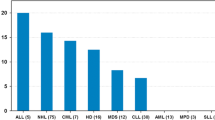Abstract
Summary
In this prospective study, we measured bone mineral density (BMD) in 1,041 cancer patients undergoing an oncological rehabilitation program in an inpatient rehabilitation clinic. There was an osteoporosis prevalence of approximately 16%, independent of sex, which is considerably higher than in the community-dwelling population.
Introduction
There is evidence that cancer patients are at risk of an increased BMD-loss following the disease and its therapy. Nevertheless, there is only little data available about the prevalence of osteoporosis in German cancer patients. Therefore, we measured BMD in 1,041 oncological inpatients undergoing rehabilitation.
Methods
From February 2006 to September 2009, BMD was measured in oncological patients with dual-energy x-ray absorptiometry (DXA; femur and spine). Statistical analysis for prevalence of osteoporosis was done in descriptive manner calculating means, standard deviation, frequencies, and 95% confidence intervals. To compare the prevalence of osteoporosis in different subgroups, χ 2 tests were done with p < 0.05. To create a risk profile, odds ratios were calculated using uni- and multivariate logistic regression.
Results
In 1,041 patients with a mean age of 57.1 years (11.0 years), DXA-measures were performed. Of them, 22% were male and 78% were female. The osteoporosis prevalence was about 16% (13.8, 18.2), independent of sex (p = 0.9722) or cancer type (p = 0.7174). As risk factors influencing the development of osteoporosis, age, weight, menopausal state, and hormone replacement therapy were identified in women and weight only in men.
Conclusions
Compared to the general population, the rate of osteoporosis is distinctly elevated in German cancer patients independent of sex or cancer type. Hence, a general recommendation for a DXA screening in these patients appears to be justified.


Similar content being viewed by others
References
Husmann G, Kaatsch P, Katalinic A et al (2010) Krebs in Deutschland 2005/2006. Häufigkeiten und Trends. 7. Ausgabe. Robert Koch-Institut, Gesellschaft der epidemiologischen Krebsregister in Deutschland e. V. (eds.). Berlin
Stava CJ, Jimenez C, Hu MI, Vassilopoulou-Sellin R (2009) Skeletal sequelae of cancer and cancer treatment. J Cancer Surviv 3:75–88
Brown SA, Guise TA (2009) Cancer treatment-related bone disease. Crit Rev Eukaryot Gene Expr 19:47–60
Brown SA, Guise TA (2007) Cancer-associated bone disease. Curr Osteoporos Rep 5:120–127
Ito K, Elkin EB, Girotra M, Morris MJ (2010) Cost-effectiveness of fracture prevention in men who receive androgen deprivation therapy for localized prostate cancer. Ann Intern Med 152:621–629
Michaud LB (2010) Managing cancer treatment-induced bone loss and osteoporosis in patients with breast or prostate cancer. Am J Health Syst Pharm 67:S20–S30
Ganz PA (2009) Survivorship: adult cancer survivors. Prim Care 36:721–741
Morote J, Morin JP, Orsola A et al (2007) Prevalence of osteoporosis during long-term androgen deprivation therapy in patients with prostate cancer. Urology 69:500–504
Spanik S, Spanikova B (2010) Bone mineral density in early breast cancer patients. Bratist Lek Listy 111:27–32
Mann GB, Kang YC, Brand C, Ebeling PR, Miller JA (2009) Secondary causes of low bone mass in patients with breast cancer: a need for greater vigilance. J Clin Oncol 27:3605–3610
Kaptoge S, da Silva JA, Brixen K et al (2008) Geographical variation in DXA bone mineral density in young European men and women. Results from the Network in Europe on Male Osteoporosis (NEMO) study. Bone 43:332–339
Tracy JK, Meyer WA, Flores RH, Wilson PD, Hochberg MC (2005) Racial differences in rate of decline in bone mass in older men: the Baltimore men's osteoporosis study. J Bone Miner Res 20:1228–1234
Häussler B, Gothe H, Göl D, Glaeske G, Pientka L, Felsenberg D (2007) Epidemiology, treatment and costs of osteoporosis in Germany—the BoneEVA Study. Osteoporos Int 18:77–84
Michaud LB, Goodin S (2006) Cancer-treatment-induced bone loss, part 1. Am J Health Syst Pharm 63:419–430
Dachverband Osteologie e.V. (2009) DVO-Leitlinie 2009 zur Prophylaxe, Diagnostik und Therapie der Osteoporose bei Erwachsenen. Osteologie 18:304–328
Kanis JA, Burlet N, Cooper C, Delmas PD, Reginster JY, Borgstrom F, Rizzoli R (2008) European guidance for the diagnosis and management of osteoporosis in postmenopausal women. Osteoporosis Int 19:399–428
Zhang R, Naughton DP (2010) Vitamin D in health and disease. Nutr J 9:65, Epub ahead of print
Neuhouser ML, Sorensen B, Hollis BW et al (2008) Vitamin D insufficiency in a multiethnic cohort of breast cancer survivors. Am J Clin Nutr 88:133–139
Crew KD, Shane E, Cremers S, McMahon DJ, Irani D, Hershman DL (2009) High prevalence of vitamin D deficiency despite supplementation in premenopausal women with breast cancer undergoing adjuvant chemotherapy. J Clin Oncol 27:2151–2156
Vashi PG, Trukova K, Lammersfeld A, Braun DP, Gupta D (2010) Impact of oral vitamin D supplementation on serum 25-hydroxyvitamin D levels in oncology. Nutr J 9:60
Kaptoge S, Reid DM, Scheidt-Nave C et al (2007) Geographic and other determinants of BMD change in European men and women at the hip and spine. A population-based study from the Network in Europe for Male Osteoprosis (NEMO). Bone 40:662–673
Maghraoui AE, Ghazi M, Gassim S et al (2010) Risk factors of osteoporosis in healthy Moroccan men. BMC Musculoskelet Disord 11:148
Conflicts of interest
None.
Author information
Authors and Affiliations
Corresponding author
Rights and permissions
About this article
Cite this article
Reuss-Borst, M., Hartmann, U., Scheede, C. et al. Prevalence of osteoporosis among cancer patients in Germany. Osteoporos Int 23, 1437–1444 (2012). https://doi.org/10.1007/s00198-011-1724-9
Received:
Accepted:
Published:
Issue Date:
DOI: https://doi.org/10.1007/s00198-011-1724-9




